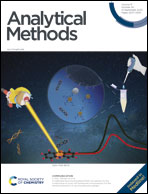A smartphone-based gold nanoparticle colorimetric sensing platform for kanamycin detection in food samples†
Abstract
The misuse of kanamycin in the breeding industry can pose a threat to human health through food exposure. Therefore, it is crucial to monitor kanamycin (Kana) levels in food. This study presents a novel colorimetric approach for detecting kanamycin based on the aggregation of gold nanoparticles (AuNPs) induced by kanamycin. To achieve this, a single-stranded DNA (ssDNA) aptamer was employed to bind the surface of AuNPs and maintain their dispersion under high salt concentrations. Upon adding Kana, the aptamer selectively binds to it and separates from the gold surface, resulting in the aggregation of AuNPs. This leads to a color change in the solution (from red to purple to blue) which can be observed under salt conditions. The proposed sensor demonstrated a linear range of 0.5–3 nM and a limit of detection (LOD) of 0.11 nM under optimal conditions. Its practicability was tested by monitoring kanamycin in six food samples, including milk, honey, vitamin C effervescent tablets, vegetable, and meat with satisfactory spiked recoveries. The sensor's miniaturization, convenience, simplicity, and low cost make it a desirable choice for fast and highly sensitive detection of Kana.



 Please wait while we load your content...
Please wait while we load your content...